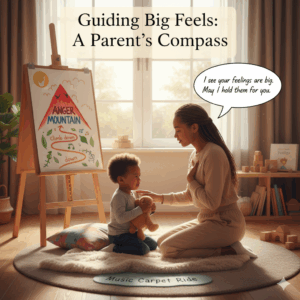This article was last updated on October 12, 2025

As moms, dads, teachers, or karate guides, we’ve all been on those days when kids just got lotsa feels anger, worries, being super upset, and so on and sometimes it ends up in big tantrums, breakdowns, or those big “flips.” It’s all part’a growing up, as we all know? Studies found that a lot of young kids throw tantrums, like, every day, and older kids sometimes can’t keep them feelings in check too.
Even if things feel a bit wild, these are chances for us to show kids how to chill out, feel them emotions, and maybe relax in a way that helps them in life overall.
Why Teaching Self-Control IS Important
So, self-control is about keeping your feels, impulses, what you focus on, and behavior in check toward a goal. It’s noticing feels, taking a pause, choosing reactions, and calming ya nerves instead a flipping out.
- When you start learning self-discipline young, some folks found that them kids do better with school, buddies, and they feel good in life.
Source: https://pmc.ncbi.nlm.nih.gov/articles/PMC5123795/ - Self-discipline’s got many sides: how your brain thinks and handles stuff (like switching on thinks, stopping themselves), emotional rules, and how you behave.
Source: https://www.frontiersin.org/journals/psychology/articles/10.3389/fpsyg.2021.717317/full - Places and who you with matter: kids first learn how to handle themselves with cool, calm adults.
Source: https://www.health.harvard.edu/blog/co-regulation-helping-children-and-teens-navigate-big-emotions-202404033030 - Playing tirelessly and just having a blast helps with self-control skills later in life.
Source: https://www.sciencedirect.com/science/article/pii/S0885200621001411
Learning self-discipline takes time it ain’t gonna happen at the snap of a finger. What they do need is lots of tries and some backup, especially when things are steaming.
Principles for Talking About Feelings
- Use Simple, Honest Language
Never use vocabulary like “upset,” “mad,” “sad,” “stressed” rather than uncertain terms.
Example: “I see you are feeling upset right now.”
This helps to control their emotional experience, which is the first step toward self-management. - Validate Without Reinforcing
You might say, “I understand this feels overwhelming. I’m here with you.”
Validation does not mean giving in it means acknowledging emotion while maintaining boundaries. - Understand Then Teach
When a child is upset, make sure to calm them down. Once your child is calm, teach them, bit by bit, about what happened and what could be done next time.
Source: https://www.health.harvard.edu/blog/co-regulation-helping-children-and-teens-navigate-big-emotions-202404033030 - Plan and Rehearse Later
After the event, reflect together:- What sparked the feeling?
- How did your body feel?
- What could you try next time?
This rehearsal helps children “preview a better ending.” Over time, they internalize the process.
- Model Your Self-Regulation
Children pay attention to how adults manage their own big feelings. If you become triggered, pause, breathe, and name your own emotion (“I feel stressed I’m going to take a breath”).
Source: https://www.stanfordchildrens.org/en/topic/default?id=anger-management-strategies-for-parents-and-grandparents-160-45&
Strategies for Calming, Regulation, and Recovery
Helping kids manage all those big feels starts with relaxed guidance and feeling what they feel. Show them how to take big, easy breaths maybe pretending like they’re blowing bubbles or sniffing a flower. Also, grounding tricks work, like “What are five things you see?” or “Can ya hear three different things?”
A quiet area or “calm spot” works good too fill it with soft stuffed animals, a cozy wrap, or fav books where kids can chill until they’re ready to join back. Stretching, doing yoga, or little strolls help get rid of stress, while being creative like drawing pictures or playing instruments lets them feel stuff safely. Kids copy us, so keeping your cool even when you’re hot shows them how to cool down, emotional wisdom wise.
Source: https://www.sciencedirect.com/science/article/pii/S0272735824000357
Studies noticed that with breathing, blinking, and yoga, anger and emotional explosions reduce a lot.
Source: https://www.sciencedirect.com/science/article/pii/S0272735824000357?utm_source=chatgpt.com
Sample Script / Flow in a Moment
- Pause and slow yourself down.
- Get to the child’s level kneel or sit.
- Acknowledge & validate: “I see your feelings are big. That must feel hard.”
- You can ask: “Want to take a breathe out together?”
- Select a soothing trick like humming quietly, rocking slowly, or taking breaths.
- Think about it later: “When you got all tense, what can we do next time?”
- Close it up: “You did awesome cooling today.”
Expanded Concepts from Research
- The “Thinker, Caveman, Boots” metaphor helps children understand how their brain works (cognitive vs. reactive).
- Co-regulation is key to calm adults help calm children.
Source: https://www.health.harvard.edu/blog/co-regulation-helping-children-and-teens-navigate-big-emotions-202404033030?utm_source=chatgpt.com - Swaddle or inward focus: even older children can benefit from going “inward” with eyes closed or wearing a soft hat.
- Swaying or mirroring helps reconnect.
- Singing resets emotional energy quickly.
- Empathy statements: “Your feelings look big may I hold them for you?”
- Changing physical level (kneeling or sitting) shows safety and understanding.
The Music Carpet Ride & Anger Mountain
Anger Mountain: Draw or imagine a mountain. The base is calm, the climb is anger rising, the peak is explosion, and the descent is calming down. Discuss how to “climb down” using breathing or rocking.
Music Carpet Ride: Lie down and imagine riding on a soft carpet as calm music plays. This imagery exercise helps children visualize calmness and release tension.
Conclusion
- The little fits ain’t bad behavior they’re what stress does to big feelings.
- Don’t be correcting or punishing when they’re mad first try to chill, then talk.
- Celebrate the tiny goods
- Tell them stories, have lots of fun, use everyday things to cheer on feelings
- Feel happy and calm first, ’cause calm spreads around. Let’s think more about how we handle those big feels, what do you say?






